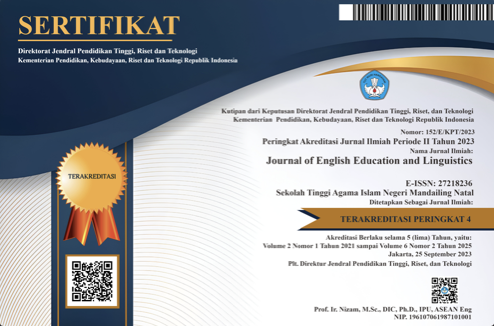A STYLISTIC STUDY OF LIWANAG’S MOST LIKED ENGLISH SONGS OF BEN & BEN
DOI:
https://doi.org/10.56874/jeel.v4i2.1586Keywords:
Ben & Ben English songs, Leech’s foregrounding theory, Leaves, Doors, The Ones We Once LovedAbstract
This study examined Ben & Ben's most liked English songs. It aimed to know how the Theory of Foregrounding of Geoffrey Leech is employed. The songs are selected from Ben & Ben’s discography of hit singles based on the timeframes– 2017-2022. The present study qualitatively examined the selected songs using the theory of foregrounding, specifically, through the lens of linguistic deviations. Amongst the seven types of linguistic deviations, this paper includes a brief analysis of the linguistic deviation—lexical and semantic as they are the sole focus of this study. The linguistic deviations in expression and structure in the songs reflect intense emotions such as love, sadness, longing, pain, struggle, and frustration. The findings showed that there were several deviations under the lexical level in the selected Ben & Ben’s songs, there were affixation and compounding, while from the semantic point of view, the findings revealed that the songwriters used metaphor, oxymorons, hyperbole, and irony. The researchers concluded that the use of linguistic deviation has a complex impact on the songs’ meaning and message.
References
Abarchah, M. (2022). The Limits of Teaching Literary Discourse: A Stylistic Approach. Studies in Pragmatics and Discourse Analysis, 3(1), 1–6. https://doi.org/10.48185/spda.v3i1.436
Ahmad, R. S., & Fahmi, I. M. (2023). A Stylistic Analysis of Dylan Thomas’ “A Refusal to Mourn the Death, By Fire, of A Child in London.” International Journal of Social Sciences & Educational Studies, 10(1), 93–105. https://doi.org/10.23918/ijsses.v10i1p93
Aljadaan, N. (2018). Understanding Hyperbole. Arab World English Journal, 1–31. https://doi.org/10.24093/awej/th.212
Amelya, D., Lestari, I., Arifin, M., Eka, F., & Rahayu, S. (n.d.). AN ANALYSIS OF REPETITION USED IN SHAWN MENDES’ SELECTED SONG LYRICS. 5. Retrieved October 25, 2023, from https://repository.unmul.ac.id/bitstream/handle/123456789/31185/4743-20292-1-PB.pdf?sequence=1
Brancatisano, O., Baird, A., & Thompson, W. F. (2020). Why is Music Therapeutic for Neurological Disorders? The Therapeutic Music Capacities Model. Neuroscience & Biobehavioral Reviews, 112. https://doi.org/10.1016/j.neubiorev.2020.02.008
Campo, S. S. (2020). An Approach to Reggaeton’s Songs: A Co-Educational and Pedagogical Proposal with Teenagers. International Education Studies, 13(7), 12. https://doi.org/10.5539/ies.v13n7p12
Dawson, Z. K. (2022). Linguistic Stylistics: Theory, Model, and Methodology. BRILL EBooks, 28–76. https://doi.org/10.1163/9789004510180_003
Dewi Max, J., Vivian, Y., Putra, B., & Kuncara, S. (2023). Transitivity Analysis of Taylor Swift’s Lyrics in Midnights Album. Indonesian Journal of EFL and Linguistics, 279–294. https://doi.org/10.21462/ijefl.v8i2.688
Fitriansyah, I., & Rosmaidar, R. (2018). PLEONASM IN THE TV SERIES THE WALKING DEAD. Jurnal Ilmiah Bina Bahasa, 11(2), 34–44. https://journal.binadarma.ac.id/index.php/binabahasa/article/view/528
Ginting, D., & Levana, E. R. (2021). Cultural Views of a Society Through Taylor Swift’s Song. INTERACTION: Jurnal Pendidikan Bahasa, 8(1), 34–49. https://doi.org/10.36232/jurnalpendidikanbahasa.v8i1.945
Griffee, D. (1992). Songs in action. Phoenix Elt.
Hadi, N. (2020, October 21). Comparative stylistics analysis on coldplay’s song lyrics. Digilib.iain-Palangkaraya.ac.id. http://digilib.iain-palangkaraya.ac.id/2774/
Hariyanto, H. (2017). The Analysis of Figurative Language Used in the Lyric of Firework by Katy Perry (A Study of Semantic). English Education: Jurnal Tadris Bahasa Inggris, 10(1), 46–60. https://doi.org/10.24042/ee-jtbi.v10i1.874
Herianah, H., Tang, M. R., & Salam, S. (2022, April 27). Linguistic Deviation in the Novel of Sayat-Sayat Sunyi By S. Gegge Mappangewa. Www.atlantis-Press.com; Atlantis Press. https://doi.org/10.2991/assehr.k.220408.049
Hussain, S., & Kamal, Z. (2023). A Stylistic Study of Javed Shaheen’s Poem I Asked the Night. Pakistan Languages and Humanities Review, 7(III). https://doi.org/10.47205/plhr.2023(7-iii)73
Hussein, M., & Hegazy, A.-R. (2020). A Linguistic Analysis of Semantic Deviation As a device of foregrounding in Selected Poems of E. E. Cummings: An Eclectic Approach1. https://aafu.journals.ekb.eg/jufile?ar_sfile=116020
Ibrahim, A., Mohammed, A., & Mugair, S. (2020). Semantic Deviation in Al-Sayyab’s The Detective and Eliot’s Ash- Wednesday Poems. International Journal of Innovation, Creativity and Change., Volume 11(Issue 10). https://www.researchgate.net/publication/343944468
Imran, M., Qayyum, N., Nabi, A. G., Majeed, A., & Majeed, N. (2021). A STYLISTIC ANALYSIS OF THE SHORT STORY “THE VARIANT” BY TANZEELA K.HASSAN. PalArch’s Journal of Archaeology of Egypt / Egyptology, 18(2), 918–926. https://archives.palarch.nl/index.php/jae/article/view/9993
Jensen, T. (2019, October 8). What is a Metaphor? | Definition & Examples. College of Liberal Arts. https://liberalarts.oregonstate.edu/wlf/what-metaphor#:~:text=By%20Tim%20Jensen%2C%20Oregon%20State
Joy, J. (2020, April 21). 13 Songs to Add to your Spring Quarantine Playlist -. https://holrmagazine.com/13-songs-to-add-to-your-spring-quarantine-playlist/
Khan, A., Khan, S., Syed, S., & Ali. (2021). Stylistic Analysis Of Foregrounded Deviationin Emilydickenson’s Poems On Death. 20(2), 2906–2929. https://doi.org/10.17051/ilkonline.2021.02.310
Latif, A., Ajmal, M., & Maqbool, S. (2022). A Stylistic Analysis of Robert Frost’s Selected Poems. Journal of Development and Social Sciences, 3(II). https://doi.org/10.47205/jdss.2022(3-ii)08
Leech, G. N. (2014). A Linguistic Guide to English Poetry. Routledge, Taylor and Francis. (Original work published 1969)
Mahmoudi, A., & Damyar, R. (2019). Investigating Deviations in the Poems of Khalilullah Khalili. Journal of Lyrical Literature Researches, 17(32), 197–216. https://doi.org/10.22111/JLLR.2019.4724
Mansoor, M., & Salman, Y. (2020). Linguistic Deviation in Literary Style Science. Cihan University-Erbil Journal of Humanities and Social Sciences, 1(2020);, 10 pages. https://doi.org/10.24086/cuejhss.vol4n1y2020.pp7-16
Meyer, J. (2018). What is Literature? A Definition Based on Prototypes. Work Papers of the Summer Institute of Linguistics, University of North Dakota Session, 41(1). https://doi.org/10.31356/silwp.vol41.03
Modu, M. M., Rufai, A., & Modu, A. (2023). A Study of Lexical Foregrounding in Niyi Osundare’s Village Voices. JALINGO JOURNAL of SOCIAL and MANAGEMENT SCIENCES, 4(4), 32–40. http://oer.tsuniversity.edu.ng/index.php/jjsms/article/view/206/194
Nordquist R. (2018). Foregrounding Definition and Examples. ThoughtCo. https://www.thoughtco.com/what-is-foregrounding-1690802
Pirnajmuddin, H., & Medhat, V. (2011). Linguistic Deviation in Poetry Translation: An Investigation into the English Renderings of Shamlu‟s Verse. Journal of Language Teaching and Research, 2(6). https://doi.org/10.4304/jltr.2.6.1329-1336
Schön, D., Boyer, M., Moreno, S., Besson, M., Peretz, I., & Kolinsky, R. (2008). Songs as an aid for language acquisition. Cognition, 106(2), 975–983. https://doi.org/10.1016/j.cognition.2007.03.005
Stylistic analysis - English language and the rules of grammar. (2009, September 13). Mantex. https://mantex.co.uk/english-language-stylistic-analysis/
Sulong, S. N. R., & Rahim, D. N. A. (2015). LARAS BAHASA DALAM LIRIK LAGU “HAKIM YANG BIJAKSANA” (LANGUAGE REGISTER IN THE SONG LYRIC “HAKIM YANG BIJAKSANA”) SITI NOOR RIHA SULONG. Journal of Business and Social Development, 3(2), 103–113.
Sun, Y. (2022). Foregrounding in English Advertisements: A Research based on Advertisements on TIME. International Journal of Linguistics, Literature and Translation, 5(3), 67–70. https://doi.org/10.32996/ijllt.2022.5.3.8
Syahputra, F. (2022). FIGURATIVE LANGUAGE IN JOHN MAYER’S SELECTED SONGS: A STYLISTIC ANALYSIS. Linguistik, Terjemahan, Sastra (LINGTERSA), 3(2). https://doi.org/10.32734/lingtersa.v3i2.10391
Teja, N. S., Utami, N. M. V., & Juniartha, I. W. (2022). Uncover the meaning of figurative language in the selected songs. Journal of Language and Pragmatics Studies, 1(1), 32–39. https://doi.org/10.58881/jlps.v1i1.5
Wardhana, I. G. N. P., Oka, I. B. M. J. R., Dewi, N. L. D. S., & Utami, G. W. N. (2022). Analysis Of Semantic In Lyn Lapid Songs. International Journal of Linguistics and Discourse Analytics, 4(1), 1–6. https://doi.org/10.52232/ijolida.v4i1.56
Widayanti, S. R. (2014). A STYLISTIC STUDY OF LANGUAGE DEVIATION IN THOMAS HARDY’S THE RUINED MAID. ISSN 0215-9511. https://citeseerx.ist.psu.edu/document?repid=rep1&type=pdf&doi=ebb2a0773d89d563a0e79c0b95244886d96f188d
Downloads
Published
Issue
Section
License
All articles published in the Journal of English Education and Linguistics are licensed under a Creative Commons Attribution-ShareAlike 4.0 International (CC BY-SA) license. This means anyone is free to copy, transform, or redistribute articles for any lawful purpose in any medium, provided they give appropriate attribution to the original author(s) and Journal of English Education and Linguistics, link to the license, indicate if changes were made, and redistribute any derivative work under the same license.
Copyright on articles is retained by the respective author(s) without restrictions. A non-exclusive license is granted to the Journal of English Education and Linguistics to publish the article and identify itself as its original publisher, along with the commercial right to include the article in a hardcopy issue for sale to libraries and individuals.
Although the conditions of the Creative Commons Attribution-ShareAlike 4.0 International (CC BY-SA) license do not apply to authors (as the copyright holder of your article, you have no restrictions on your rights), by submitting to the Journal of English Education and Linguistics, authors recognize the rights of readers and must grant any third party the right to use their articles to the extent provided by the license.

This work is licensed under a Creative Commons Attribution-ShareAlike 4.0 International License.








